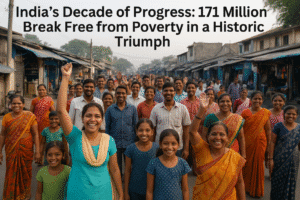India’s Decade of Progress: 171 Million Break Free from Poverty in a Historic Triumph
India achieved a landmark reduction in extreme poverty over the past decade, lifting 171 million people above the $2.15/day threshold between 2011–12 and 2022–23, as reported by the World Bank. Extreme poverty plummeted from 16.2% to 2.3%, with rural areas seeing a dramatic drop from 18.4% to 2.8% and urban rates falling from 10.7% to 1.1%, narrowing the rural-urban gap significantly. Progress extended beyond income: multidimensional poverty, which includes education and healthcare access, halved to 16.4% by 2019–21.
Five populous states drove two-thirds of this decline, yet still house 54% of India’s remaining poor. Despite employment growth outpacing the working-age population since 2021, challenges like youth unemployment (13.3%, rising to 29% for graduates) and informal labor persist, with only 23% of non-farm jobs being formal. Gender gaps remain stark, with 234 million fewer women in paid work than men. While India’s strides mirror global poverty reduction successes, sustained focus on regional equity, job formalization, and inclusive policies will be critical to securing long-term gains.

India’s Decade of Progress: 171 Million Break Free from Poverty in a Historic Triumph
Over the past decade, India has achieved a historic milestone in its fight against poverty, lifting 171 million people out of extreme deprivation between 2011–12 and 2022–23, according to the World Bank’s Poverty & Equity Brief. This transformation reflects a dramatic decline in extreme poverty—defined as living on less than $2.15 per day—from 16.2% to just 2.3%. Rural areas, once the epicenter of deprivation, saw poverty rates plummet from 18.4% to 2.8%, while urban poverty dropped from 10.7% to 1.1%. The rural-urban divide narrowed significantly, with the gap shrinking by 16% annually, signaling more inclusive growth.
Breaking Down the Numbers: From Survival to Stability
The World Bank’s data underscores broader progress beyond extreme poverty. Using the lower-middle-income benchmark of $3.65 per day, poverty rates fell from 61.8% to 28.1%, lifting 378 million people into greater economic security. Rural regions experienced the most profound shifts, with poverty declining from 69% to 32.5%, compared to urban areas’ drop from 43.5% to 17.2%. This progress reflects decades of policy focus on rural development, including initiatives like the Mahatma Gandhi National Rural Employment Guarantee Act (MGNREGA), which provided wage security, and campaigns to improve sanitation, healthcare, and financial inclusion.
Regional Disparities: Progress and Persistent Gaps
Five states—Uttar Pradesh, Maharashtra, Bihar, West Bengal, and Madhya Pradesh—accounted for 65% of India’s extreme poor in 2011–12. While these states contributed significantly to poverty reduction, they still represent 54% of the remaining extreme poor. This highlights entrenched regional disparities, demanding targeted interventions. The Multidimensional Poverty Index (MPI), which measures non-monetary factors like education and healthcare access, reinforces this narrative: MPI rates fell from 53.8% in 2005–06 to 16.4% by 2019–21, driven by schemes like Swachh Bharat (clean water access) and Ayushman Bharat (healthcare coverage).
Employment: Growth Amid Informality
India’s working-age population has grown alongside employment opportunities, with urban unemployment hitting a seven-year low of 6.6% in early 2024. However, structural challenges persist:
- Youth Unemployment: At 13.3% overall, this surges to 29% among tertiary-educated youth, pointing to a skills mismatch.
- Informal Labor: Only 23% of non-farm jobs are formal, and agriculture remains overwhelmingly informal.
- Gender Gaps: Despite rising female labor participation, 234 million more men than women hold paid jobs, underscoring systemic barriers.
A notable shift is the rise in self-employment, particularly among rural women, suggesting entrepreneurial activity but also limited formal job availability. Post-2021, male workers increasingly migrated to urban areas, likely reflecting pandemic recovery and urban job resurgence.
The Road Ahead: Sustaining Momentum
While India’s progress is commendable, sustaining it requires addressing lingering gaps:
- Formal Job Creation: Expanding manufacturing and tech sectors, coupled with vocational training, could absorb educated youth.
- Regional Equity: Targeted investments in lagging states to improve infrastructure, education, and healthcare access.
- Gender Inclusion: Policies to bridge workforce participation gaps, such as affordable childcare and safer workplaces.
- Social Safety Nets: Strengthening programs like PM-KISAN (farmer income support) to shield vulnerable populations from economic shocks.
A Global Perspective
India’s success mirrors China’s rapid poverty reduction in the late 20th century, positioning it as a leader in achieving the UN’s Sustainable Development Goals. However, the journey is incomplete. As World Bank researchers note, translating economic growth into equitable opportunities remains critical.
In summary, India’s decade of progress offers a blueprint for poverty eradication, yet the path forward demands innovation, inclusivity, and relentless focus on human capital. The world will be watching.
You must be logged in to post a comment.